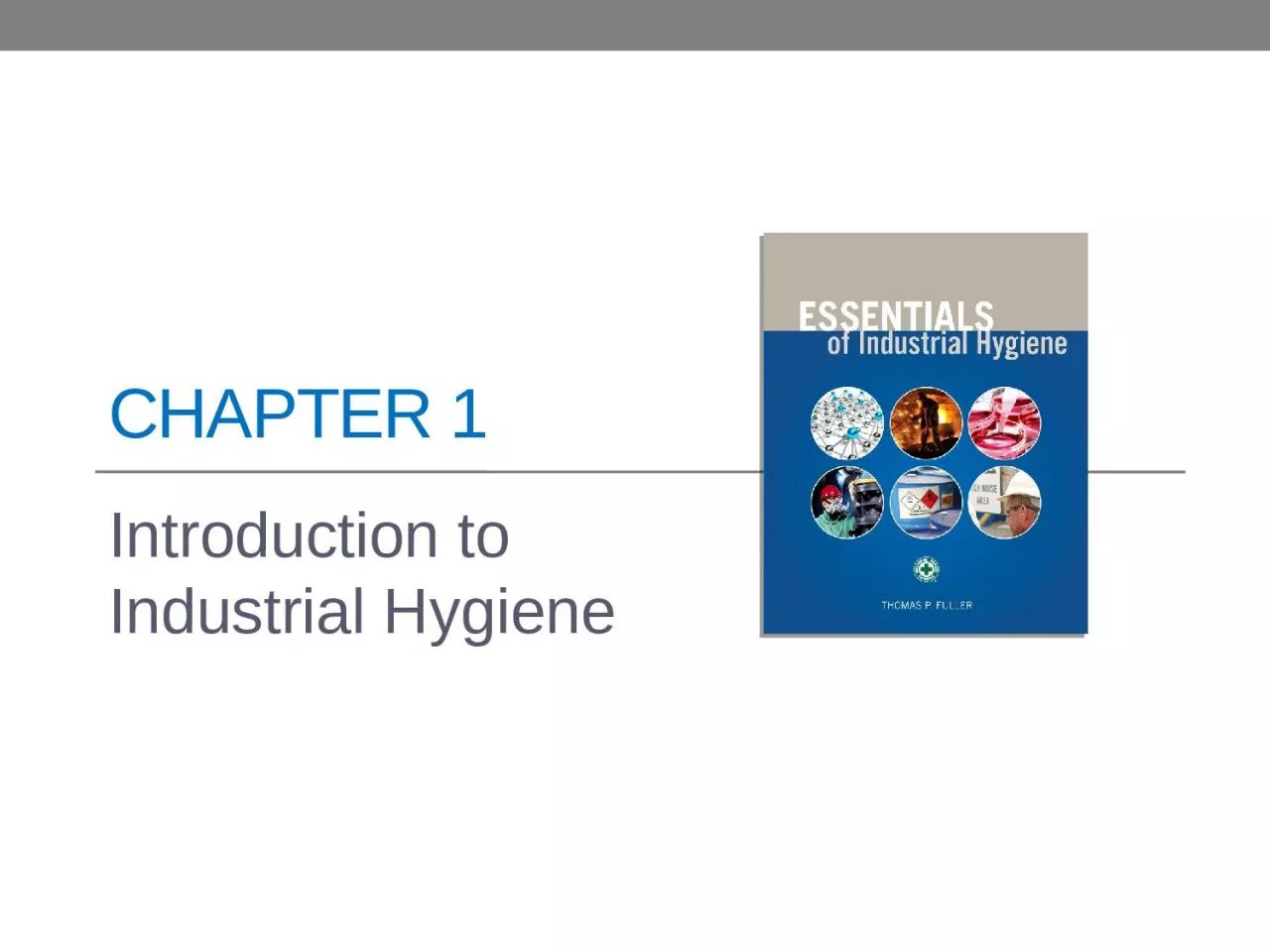

Industrial Hygiene Learning Objectives Briefly explain the relevance and importance of the practice of industrial hygiene in society today and throughout history Explain the types of sciences and studies that comprise the field of industrial ID: 1009177
Download Presentation The PPT/PDF document "Chapter 1 Introduction to" is the property of its rightful owner. Permission is granted to download and print the materials on this web site for personal, non-commercial use only, and to display it on your personal computer provided you do not modify the materials and that you retain all copyright notices contained in the materials. By downloading content from our website, you accept the terms of this agreement.
1. Chapter 1Introduction to Industrial Hygiene
2. Learning ObjectivesBriefly explain the relevance and importance of the practice of industrial hygiene in society today and throughout history.Explain the types of sciences and studies that comprise the field of industrial hygiene.Describe the differences between pathways of exposure and routes of exposure to hazardous agents.List general types of workplace hazards.Identify the basic health effects of hazardous exposures in the workplace.Describe the concept of risk and the fundamental principles that it is based upon.Discuss the basic tenets of industrial hygiene hazard assessment and control.Recognize the types of careers and industries available for professional industrial hygienists.Briefly describe the various government agencies and professional organizations with roles in industrial hygiene.
3. Industrial Hygiene Definition“That science and art devoted to the anticipation, recognition, evaluation, and control of those environmental factors or stresses arising in or from the workplace that may cause sickness, impaired health and wellbeing, or significant discomfort among workers or among the citizens of the community” (AIHA).
4. Industrial Hygiene TodayChemistryPhysicsPhysiologyAnatomyToxicologyMathematicsBiologyStatisticsEpidemiologyEngineeringPsychology/organizational behaviorSocial scienceErgonomicsRisk assessmentManagementEthics
5. Pathways of ExposureAirWaterFoodAnimalsPeopleSurfaces
6. Significant Routes of ExposureInhalationSkin and eye absorptionWhat does skin notation mean?IngestionPercutaneousSource: National Institutes of Health, http://www.nhlbi.nih.gov/health/health-topics/topics/hlw/system
7. Chemical HazardsFlammableReactiveCorrosiveToxicExplosiveCarcinogenicSensitizing
8. Physical HazardsNoiseIonizing radiationNonionizing radiationThermal stress (hot/cold)Vibration
9. Musculoskeletal HazardsForce DurationAwkward postureRepetitive
10. Biological HazardsInfectiousDisease causing
11. Workplace Agents and Hazards
12. Injury versus DiseaseInjury = direct physical outcomeDisease = may involve a progression
13. Acute ExposureAn exposure that occurs over a short period
14. Chronic ExposureA lower level exposure that occurs over a long period of timeDays, weeks, months, years
15. Acute Health EffectsSeen shortly after exposureMay be reversibleHearing lossHeadacheDizzinessSkin redness
16. Chronic Health EffectsMay take a long time to occur or noticeCancerBone degenerationHearing lossSilicosisEmphysema
17. RiskProbabilitya branch of mathematics that measures and describes the relative likelihood or frequency of an event and looks at the distributions of the event’s occurrences within a given population.SeverityThe level of hazard associated with a possible exposure
18. AnticipationIdentifying potential or actual hazards through knowledge of materials, operations, processes, and conditions in the workplace.Using available information from a variety of sources.
19. RecognitionThe observation and discovery of the hazardous materials and conditions in the workplace.Using observation and process mapping to understand and document processes and possible exposures to workplace hazards.
20. EvaluationMeasure exposures and doses, and comparing the measurements to regulatory, professional, and other exposure standards and limits.Measures could include air monitoring, ergonomic observations, review of accident and injury records, and worker interviews.Quantitatively evaluate and document levels of exposure.Prioritize jobs with the most significant hazards.
21. Control of HazardsThe elimination or reduction of identified and measured hazards.Use the hierarchy of controls to eliminate or reduce hazards.
22. Elimination and SubstitutionCompletely eliminate the hazard from the workplace.Stop the use of a particular toxic or flammable chemical used in the process or product.Reduce the quantity of a particular hazardous chemical used.Change the chemical to a safer or less hazardous one.Change the work process to cut out the hazardous activity or materials used.
23. Engineering ControlsStructures, systems, or devices that physically separate, or protect the worker from the hazard.Barriers, walls, enclosures, covers, guards, shields.Ventilation systems, fume hoods.Distance (moving the hazard farther away from the workers).
24. Administrative ControlsPrograms PoliciesProceduresLabelsWarning signs or lightsTraining
25. Personal Protective EquipmentRespiratorsGlovesLab coatsEyewearFootwearLead apronsFace shieldsEar muffs
26. Industry Careers• Manufacturing• Health care• Research/education• Transportation• Insurance• Agriculture• Public utilities• Construction• Energy• Waste management• Mining
27. Government CareersEnvironmental Protection AgencyFederal Communications CommissionNuclear Regulatory CommissionNational Institutes of Health’s Center for Disease Control and PreventionPublic Health ServiceChemical Safety BoardNational Institute for Environmental Health StudiesConsumer Product Safety CommissionDepartment of EnergyMine Safety and Health AdministrationNational Transportation Safety Board
28. Job PathsConsultingLaboratory analysisManagementExposure assessment and controlResearchPolicy and regulation development and analysisQuality assuranceErgonomicsNoise assessment and controlRadiation safety
29. Professional OrganizationsAmerican Industrial Hygiene AssociationAmerican Society of Safety EngineersAmerican Conference of Governmental Industrial HygienistsNational Safety CouncilHealth Physics SocietyHuman Factors and Ergonomics SocietyAmerican National Standards Institute